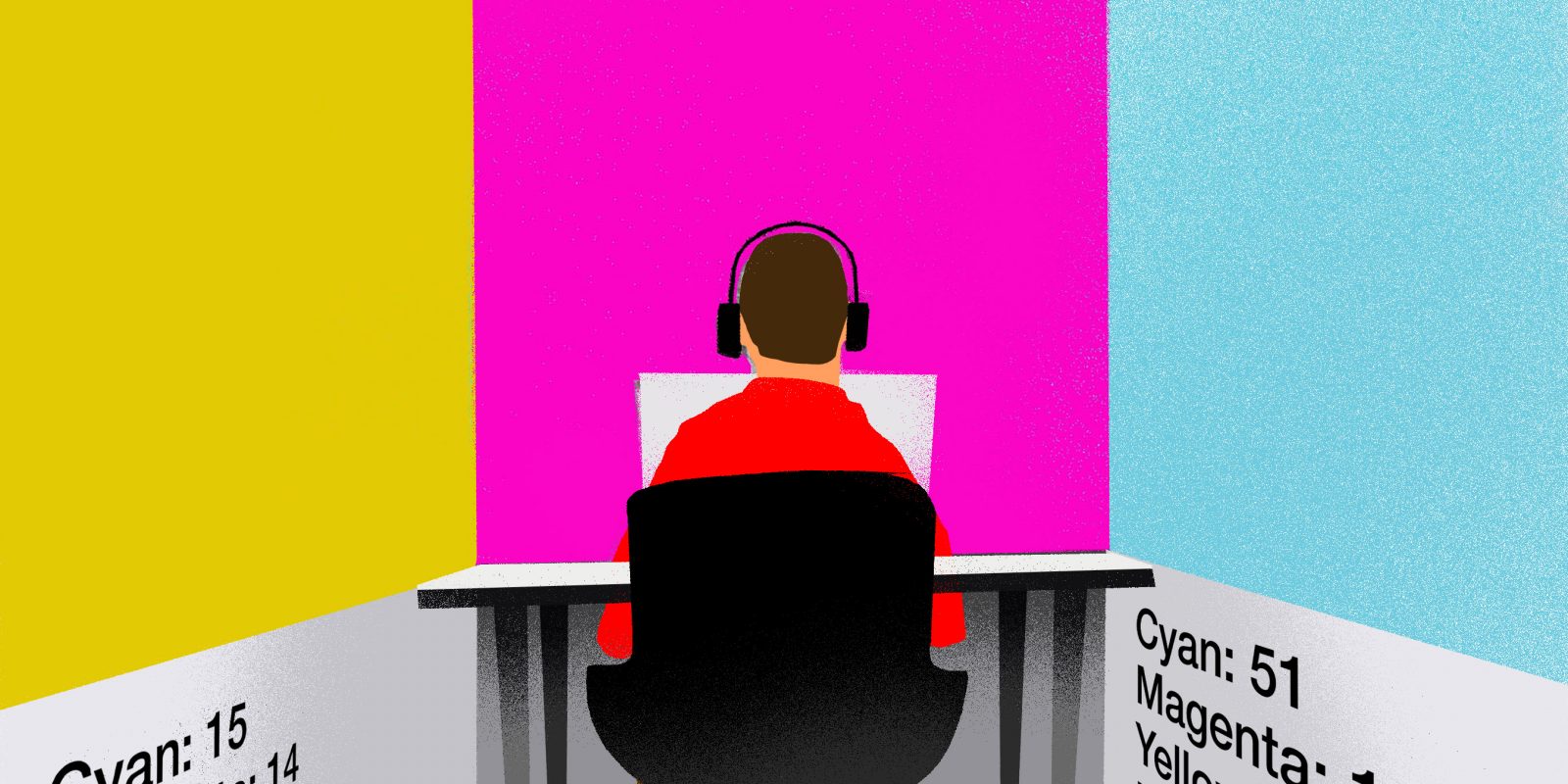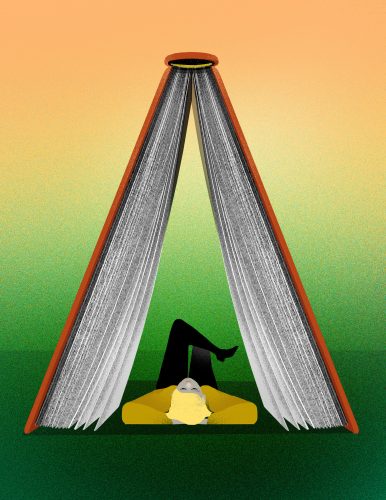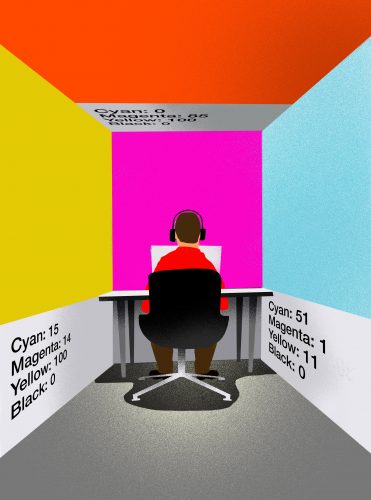
Illustration by Brian Stauffer
Insights Into Introverts
Quiet workers, often overshadowed, bring balance to an office.
An ideal workday for Ma’lisa Yost is a balance of team meetings, chats with co-workers and quiet time to write and think on her own.
“I like to engage with small groups or one-on-one with people,” she said. “I don’t mind being in a big group, but I might not say anything.” Later on, Yost might email someone “and give them feedback, if I think they’re open to it.”
Yost, the assistant director of advancement communications at TCU, said she often feels her best conversations are in small groups or with just one other person, allowing her to tune into and engage with her colleagues.
For Gorland Mar, director of graphic design at TCU, an ideal day includes meetings where he can listen to his colleagues’ needs and feedback or gather input from his teammates on projects — and also spending some time alone to put his creative skills to good use.
“That’s how I prefer to work, to really get in my own physical space where there’s just nobody around,” he said. “Not to say that I can’t handle interruptions, but I feel I create best when I’m in my space.”
Personifying Personalities
Albert Einstein was one well-known introvert. Elon Musk is another. Warren Buffett, Bill Gates, Meryl Streep and J.K. Rowling, all masters of their respective fields, are introverts. Even tireless leaders can be introverts; consider Eleanor Roosevelt or Barack Obama.
Carl Jung introduced the terms introversion and extroversion into psychology in his book Psychologische Typen (Rascher, 1921). Jung defined introversion as “inwardly directed psychic energy.” Extroverts, he theorized, prefer to engage with the outside world of objects, sensory perception and action, while introverts focus on the internal world of reflection and are thoughtful and insightful.
Cathy Cox, graduate director and associate professor of psychology, cautioned against labels that define individuals as one or the other. She said that personalities exist along a wide continuum.
In the 21st century, Cox said, psychology turns to the Big Five, a tool used to delineate five traits of personality, one of them being extroversion. OCEAN, an acronym for these five dimensions of personality measurement, encompasses openness to experience, conscientiousness, extroversion, agreeableness and neuroticism. An individual’s unique personality also can be characterized by subtraits within each of those dimensions.
“Introverts are usually shy, quiet, focused inward, reserved,” Cox said. On the other hand, a personality that tends toward being “loud, outgoing, sociable and the life of the party” describes someone who leans toward extroversion.
Energy Balance
The main difference between introversion and extroversion is “really about how you respond to stimulation,” Cox said. “We put ourselves in a zone of stimulation that works for us.”
For some people, the best thinking is done in a quiet atmosphere. Others find clarity in a room full of people and action.
“I get my energy being alone or with someone I’m really comfortable with,” Yost said. “I’m in an office with three other people who are also writers, and everyone is very considerate of the others because we all have similar personalities.”
“Stimulation comes in all forms — social stimulation, but also lights, noise and so on. … Many people believe that introversion is about being antisocial. That’s a misperception: Introverts are just differently social.”
Susan Cain
Yost said that as an introvert, she fights a stigma. “Introversion can have a negative connotation, but it doesn’t mean you don’t have friends or that you can’t be outgoing,” she said. “It just means you get your energy from within instead of interacting with other people.”
A preference for less stimulating, less active environments is a hallmark of someone who ranks high in introversion, said Susan Cain, author of Quiet: The Power of Introverts in a World That Can’t Stop Talking (Crown, 2012). “That’s where they feel most alive and most energized,” she wrote in an email. “In contrast, extroverts crave more stimulation to feel at their best.
“Stimulation comes in all forms — social stimulation, but also lights, noise and so on,” she wrote, “so an introvert is more likely to enjoy a quiet glass of wine with a close friend than a loud, raucous party full of strangers. Many people believe that introversion is about being antisocial. That’s a misperception: Introverts are just differently social.”
Cain’s revelations about the quieter personality type have gone viral; her TED Talk on the power of introverts has been viewed more than 30 million times.
While people whose personalities lean toward introversion work in every field, they are often attracted to careers in which they can do tasks independently, Cain wrote. Graphic design, engineering, accounting, photography, research, writing and information technology are among fields that offer the kind of stimulation best suited for someone who prefers to think and create alone.
Genetic Disposition
“I was drawn toward visual things like graphics and illustrations, including comic books,” Mar said of his childhood. “A lot of it was imagination and role-playing. We could get some friends together and start dialoguing, making up an episode of some TV show or something. But I also enjoyed just sitting down and starting to draw something.”
Yost said her immediate family members are also introverts. “We’re all readers, and everybody in my family enjoys being alone. They still want interaction with people, but they’re comfortable being by themselves,” she said. “Growing up, my mom always put value in entertaining yourself, in not needing a lot of attention or assistance in making yourself happy. But I also think I was born this way.”
Genetics do play a part, Cox said, though the surrounding environment works to shape and mold people as well. “Evidence shows that around 30 to 50 percent of our personality is genetically based, with some traits being more heritable than others,” she said, citing the work of Harvard University psychological researcher Jerome Kagan on behavioral inhibition in children.

Illustration by Brian Stauffer
Kagan and his colleagues observed toddlers’ reactions to a variety of stimulants, including encounters with unfamiliar toys, interactions with female strangers, exposure to a large, odd-looking robot and separation from their mothers.
Subsequent studies reassessed these children, exposing them to novel situations. At 6 years old, children who had exhibited behavioral inhibitions as toddlers showed greater physiological responses, including salivary cortisol levels, muscle tension, heart rate and pupillary dilation, than those of children who had been categorized as uninhibited when presented with new stimuli.
Researchers concluded that the threshold for activation of the endocrine system might be lower for inhibited children than for uninhibited children, creating different physiologic responses. These reactions may help explain why some people gravitate toward calmer environments.
“The research shows that we have a predisposition to act a certain way. We’re either shy and quiet or we’re outgoing and sociable and need that chaos,” Cox said. Someone who rates highly on introversion, for example, might have a satisfactory level of stimulation by working alone in an art studio, while someone who ranks highly on extroversion might experience that same level of satisfaction from the stimulation of a loud group event. The physiological responses are similar while the stimuli can be wildly different.
Workplace Dynamics
People whose preferred level of stimulus aligns with a more introverted style can find themselves in an uphill battle in a Western culture of personality. In school or in the workplace, for example, outgoing, gregarious, quick-witted personalities can be seen as more competent than people who focus on quietly listening in group settings and pausing to think and make decisions.
“Some argue it’s a Western ideal, one that is not as prevalent in collectivist cultures,” Cox said.
“Extroverts tend to tackle assignments quickly. They seize the day; they just do it. They make fast decisions and are comfortable multitasking and risk-taking. The downside is that their decisions can be rash; they sometimes leap before they look,” Cain wrote. Introverts, on the other hand, work more slowly and deliberately, focusing on one task at a time.
“To sit and think and go through something carefully … it’s kind of hard to separate my personality traits from my introversion,” Yost said. For example, she prefers to gather all the information required before beginning to write a document, researching the topic at hand before creating her position. “I’ll try to hit all the different resources and not leave anything unturned, which takes time.”
Her introversion draws Yost’s colleagues to her when they need proofreading because “they know I’m meticulous,” she said. Former co-workers “gave me a T-shirt that said, ‘Does anal retentive have a hyphen in it?’ ”
“The introvert on your team is picking up details and thinking quietly, going to a deeper level of analysis than an extroverted individual, who may be doing something more superficial.”
Cathy Cox
Putting Personalities to Work
Cox said optimal work teams contain a balance of introverts and extroverts. “The introvert on your team is picking up details and thinking quietly, going to a deeper level of analysis than an extroverted individual, who may be doing something more superficial.”
Introverts tend to think more independently and are less swayed by others’ perspectives, she said. “To get a full gamut of perspectives, you want an integration of the two.”

Illustration by Brian Stauffer
Mar said he is a “sit back and see” person who is able to fill a variety of roles on a team based on what he observes is needed. He also emphasized the role that listening plays in group dynamics. “Listening is the key to communication, and that’s what graphic design is about: communication. The better listener you are, the better communicator you’ll be.”
Introverts like to think before they speak, Cain wrote. “Sometimes they feel frustrated by meetings happening very quickly and in what can feel to them an unconsidered way. Extroverts, on the other hand, can feel understandably frustrated when introverts are taking so much time to think things through that they don’t share their ideas.”
People who don’t speak up often in meetings can be misunderstood as disinterested or disengaged. “The truth is that large meetings are often not the best way to get the best of introverts’ brains,” Cain wrote, citing a study from the Kellogg School of Management that found in a typical meeting of six to eight people, three people do 70 percent of the talking.
“This is a very worrisome statistic for anyone who wants to make sure that the best ideas and decisions are coming to the fore. We need to rethink how we run our meetings — and how often we hold them.”
Cox said leaders should not force an agenda that may not be in a teammate’s comfort zone. “We know that introverted people don’t want to be the center of attention, nor do they want to be put on the spot to make a speech,” she said. Seek them out individually for their feedback and give them the time they need. “They’re gathering facts and putting an argument together. … Give them time to process the information; it benefits them and their personality type.”
Neither introverts nor extroverts exist in a vacuum, Cain wrote. Working together, introverts and extroverts can benefit from each other’s strengths in a sort of yin and yang approach to collaboration. One example is that of Steve Wozniak and Steve Jobs. Noted introvert Wozniak, the engineer and computer programmer who invented the Apple computer, collaborated with Jobs, a gifted public speaker with extroverted tendencies, to create Apple Inc. to pioneer incredible technology and bring it to market.
Appropriate levels of workplace stimulation are important for everyone, Cox said. Yost has served in several roles during two different tenures at TCU, her current stint a 20-year-plus term. Mar is going on 30 years of service to the university.
“The numbers speak for themselves,” Mar said in describing his satisfaction with his role. “I think that says something not just about me but about the environment, too, and how I feel I’ve been valued here. I’m very grateful and very thankful.”

In Quiet, Susan Cain finds that we dramatically undervalue introverts and shows how much we lose in doing so. (Crown, 2012)
Creating an Introvert-Friendly Workplace
Susan Cain, author of Quiet: The Power of Introverts in a World That Can’t Stop Talking, shared advice for creating an inclusive workplace for people whose personalities tend toward introversion:
Apportion work time appropriately. “Introverts thrive with more quiet time, while extroverts need more participatory time.”
Consider accolades. “When rewarding people for a job well done, think about their personality style: An introvert may not relish a big dinner with the team. Instead, give them a day off to spend time as they please.”
Plan your space. “Make sure to give people private office space or, if you use an open office plan, to include nooks and crannies throughout the office where people can be by themselves.”
Mix up your processes. “When it comes to idea generation, use a hybrid process in which people do a significant part of their creative work on their own — and then come together to share what they’ve come up with. We all work and think better this way — extroverts included!”
— Rachel Hedstrom
Introvert or Extrovert?
In the workplace, recognizing and honoring introverts’ and extroverts’ differences can help personalities work together with greater understanding.
Introvert |
Extrovert |
Preference for solitude |
Outgoing |
Observe first and act later |
High energy |
Think better by themselves |
Talkative |
Draw energy from reflection |
Draw energy from other people |
Calm |
Enthusiastic |
Seek calm environments |
Seek new experiences |
— Amanda Vasquez

Your comments are welcome
Comments
Related reading:
Research + Discovery
Extroverted CEOs May Make Investors Nervous
Joseph Harrison finds a leader’s personality traits may matter to stockholders.
Alumni, Features
Arnie Gachman Makes Fort Worth Better
The industry titan-turned-philanthropist strives to make his city a healthier and more just place.
Sports: Riff Ram
Maggie Martin Leads the Dutchmen
In purple and white overalls, the senior leads the TCU student sections on game day.